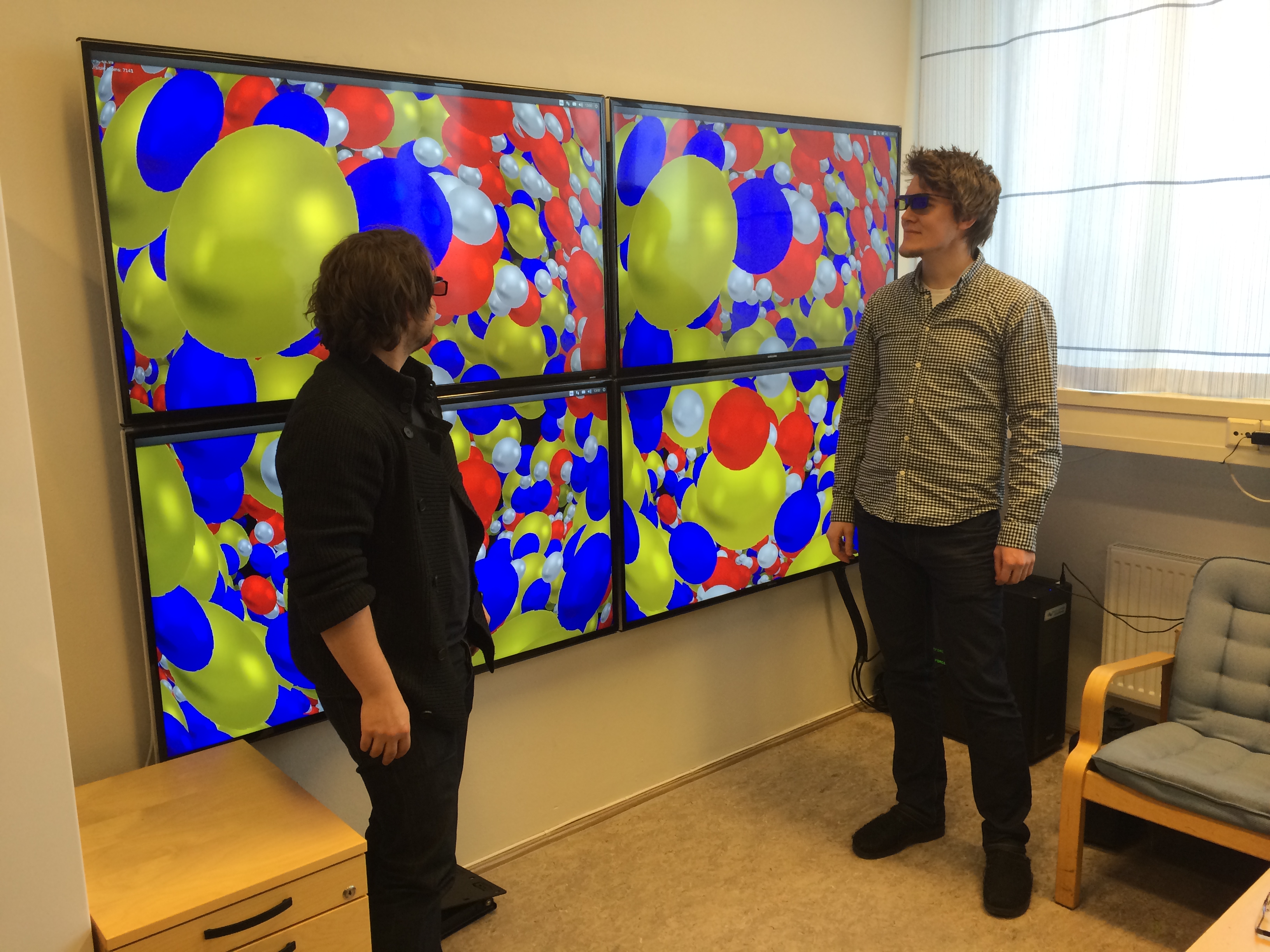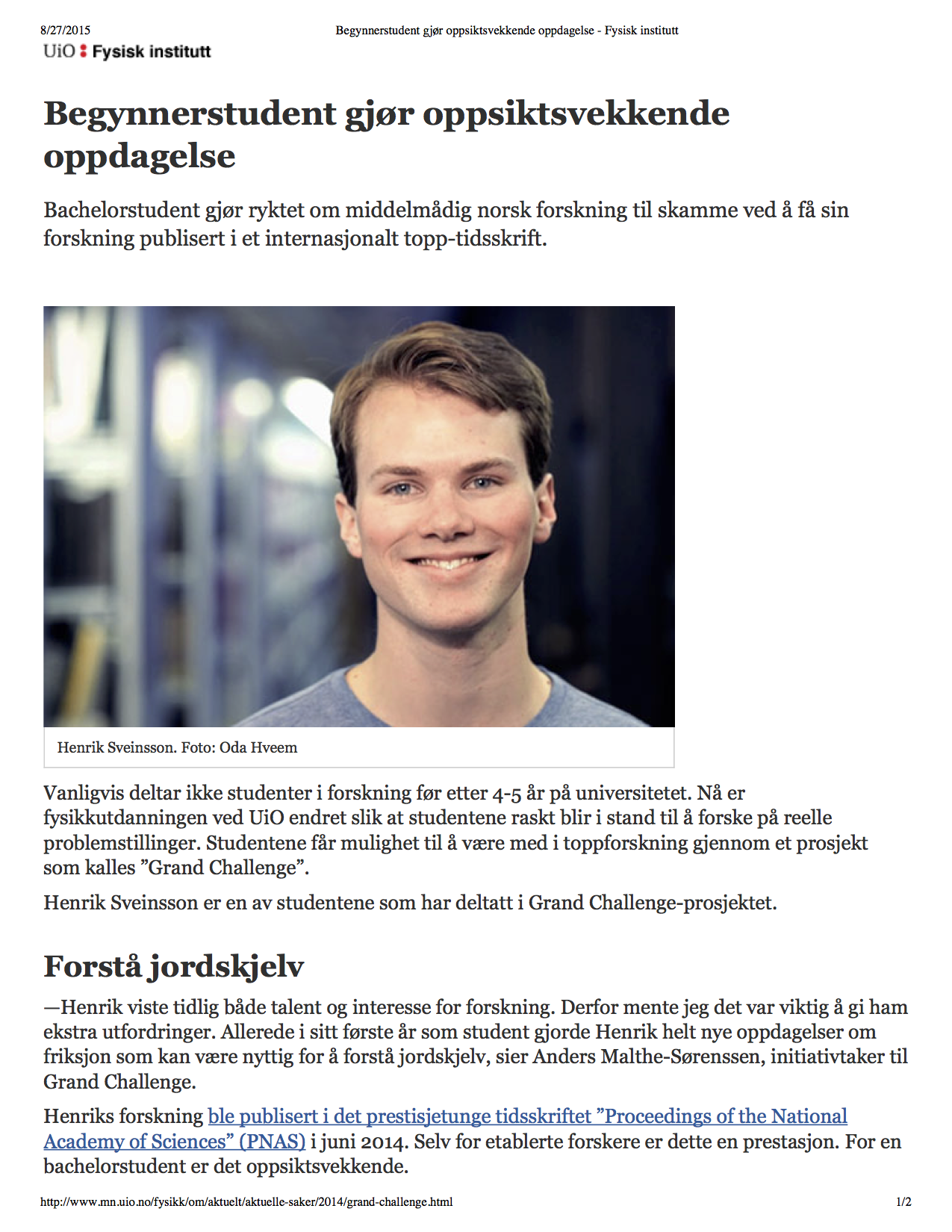Education for the future
September 2 2015,
Present and future education
- Research-based education, from undergraduate studies to a PhD: The Computational Physics group at the University of Oslo as example
- Future challenges and directions
Excellent research depends on excellent education --- and vice versa!
The role of computations, from education to society
Computations are central to our basic understanding of nature and to technological advances. UiO's strength in computational science (education and research) has the potential to make UiO a top European university.
- Nanotech and Materials: quantum physical systems in nanotechnology; characteristics of new materials; semi-conductor devices and quantum computers
- The smallest particles in nature: subatomic physics at its smallest length scale
- And the largest: simulating galaxies and the evolution of the universe
- Life science: cancer treatment and how the brain works
- Geosciences: predicting climate changes and this week's weather, simulating natural disasters
- Finance: assessing risk in the insurance and financial industry
- and many many more
Modeling and computations as a way to enhance algorithminc thinking
Algorithm : A set of instructions to solve a problem.
Algorithmic thinking applies to all disciplines. It
- Enhances instruction-based teaching
- Introduces research-based teaching from day one
- Triggers further insights in scientific problems
- Emphasizes validation and verification of scientific results, and integrates science ethics in a natural way
- Ensures good working practices from day one!
What does computing mean?
Computing means solving scientific problems using computers. It covers numerical as well as symbolic computing. Computing is also about developing an understanding of the scientific process by enhancing the algorithmic thinking when solving problems.
- derivation, verification, and implementation of algorithms
- understanding what can go wrong with algorithms
- overview of important, known algorithms
- understanding how algorithms are used to solve complicated problems
- reproducible science and ethics
- algorithmic thinking for gaining deeper insights about scientific problems
All these elements (and many more) aid students in maturing and gaining a better understanding of the scientific process per se.
Computing and research-based education
A computational approach allows us to introduce research concepts and engage students in research from day one.
- Theory + experiment + simulation is the norm in research and industry
- Modeling of real, complex systems with no simple answers
- Insight and understanding of fundamental principles and laws
- Visualization, presentation, discussion, interpretation, and critical analysis of results
- Development of a sound ethical attitude to own and other's work
- Enhanced reasoning about the scientific method
- Individually tailored education in order to let students realize their full potentials and discover their creative powers
This is what we do in the Computational Physics group at UiO!
Computational Physics group at UiO; our visions
|
|
Student dreams
A social and scientific learning environment
Goal: Students should realize their full potentials and discover their creative powers
- Students come with different dreams, ambitions, aspirations and topics they wish to study, our approach is to tailor the education to all these aspects
- Our motto: foster students who are better than their supervisors
- Emphasis is on learning and getting new insights
- Students and teachers help each other
- Students with different backgrounds and needs can thrive socially and scientifically
- Non-competitive and generous environment
We develop a social and scientific learning environment
- We target bachelor, MSc and PhD students
- Project-oriented work where students develop and mature their own ideas, with an individually tailored approach to each student
- Office space with desktops to every student and large common room for recreational activities (meals, gaming, movies)
- Many students collaborate on similar thesis topics and publish in top scientific journals
Features of the Computational Physics group
- Our students have made significant contributions to the Computing in Science Education (UiO education prize in 2011) by developing exercises and participating in educational projects at the MN faculty
- Our students have also developed educational tools and applications for understanding complicated physical problems
- A group of PhD students is now developing new textbooks for Computational Life Science
- 2005-2015: \( > 60 \) students have finalized their master's theses and 60% have continued with PhD studies
- Many students don't want to leave the group after finishing their studies
Investing in equipment for research and education
|
Large screens for visualizing and presenting scientific results. And gaming and other social activities.
|
|
Building a local supercomputing cluster from titan.uio.no
|
Our supercomuting cluster.
When UiO's previous supercomputing cluster (titan.uio.no) was replaced by abel.uio.no, we got 200 nodes for free from USIT and built our own supercomputer. The value in 2006 of all the equipment was close to eight MNOK.
|
|
Undergraduate student publishes in PNAS
|
Participating in research from day one!
|
|
The computational revolution in science in society
- Computing will affect all aspects of society - and should also play a key role in research and education in our society
- Possible large shifts with the advent of automation
- Present and future problems involve complex systems
- Require a multi-disciplinary approach
- Collaboration and team work using computational tools
- To stay competitive as a society we need computing competence integrated in all fields – for both research and education!
- We need candidates with the right multi-disciplinary background and skills in computational thinking
Multiscale modeling is the big open research question in the 21st century
- Present and future problems, unlike traditional science and engineering, involve complex systems with many distinct physical processes
- The wide open research topic of this century, both in industry and at universities, is how to effectively couple processes across different length and energy scales
- Progress will rely on a multi-disciplinary approach
We need to foster candidates with the right multi-disciplinary background and computational thinking!
UiO has a unique opportunity to become a Leading European University
UiO's strength in computational science (education and research) has the potential to make UiO a top European university
- We must educate the competence needed
- We are in a unique position to do so --- across all fields!
- Establish a new center/department with focus on computational science and its applications to a wide range of fields (natural science, medicine, social sciences, humanities, applied research etc)
- Hire ten young professors (age \( < 40 \)) dedicated to innovative computational research and education
- Establish another ten professorships with shared positions between the new department and the discipline-specific department
- Establish best practices for computational and educational innovations, with a particular focus on new learning material and real incentives
The process must start now in order not to lose momentum.
Our takeaway messages
- Computing plays and will play an even more important role in society --– and this must be reflected in research and education
- Our program builds in this and allows students to realize their potential and unleash their creativity
- Social and scientific activities in harmony
- UiO is in a unique position to develop a leading research and educational activity --- if we act now
Computational Physics and the Computing in Science Education project (UiO educational prize in 2011)
The results, insights, ideas and thoughts presented here, would have been impossible without the infinitely many interactions with colleagues in the Computing in Science Education project and all our fantastisc students who continuously give us new insights! Thanks
|
|




